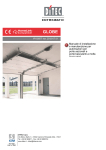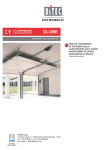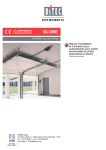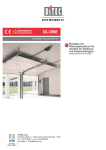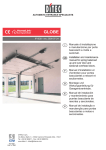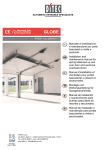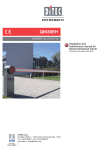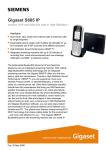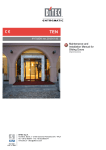Download DITEC GLOBE Technical data
Transcript
GLOBE IP1839EN- rev. 2012-07-31 EN Installation and maintenance manual for automations for sectional overhead doors and spring balanced up-and-over doors. (Original instructions) DITEC S.p.A. Via Mons. Banfi, 3 - 21042 Caronno Pertusella (VA) - ITALY Tel. +39 02 963911 - Fax +39 02 9650314 www.ditec.it - [email protected] INDEX Subject 1. General safety precautions 2. Declaration of incorporation of partly completed machinery Page 2.1 Machinery Directive 3. Technical data 3.1 Operating instructions 3.2Dimensions 4. Standard installation 5. Main components 6. Assembling belt and chain 7. Assembling the automation 8. Tensioning belt and chain 9. Mechanical installation 10. Fastening the arm 11. Installation of the end stops 12. Installation of the manual release 13. Installation of the GLOBEC adapter for up-and-over doors 14. Installation of the GLOBESI intermediate support 15. Electrical connections 16.Commands 17. Outputs and accessories 18.Settings 19. Radio receiver operation 20. Start up 21.Troubleshooting 22. Routine maintenance plan 23. Operating instructions 23.1General safety precautions 23.2Manual release instructions 3 4 4 5 6 6 7 8 9 10 11 12 13 14 14 15 16 17 18 19 20 22 23 24 24 25 25 26 CAPTION This symbol indicates instructions or notes regarding safety issues which require particular attention. i This symbol indicates informations which are useful for correct product function. This symbol indicates instructions or notes intended for technical and expert personnel. STOP This symbol indicates operations not to be effected for not compromise the correct operation of the automation. This symbol indicates options and parameters which are only available with the indicated item. This symbol indicates options and parameters which are not available with the indicated item. All right reserved All data and specifications have been drawn up and checked with the greatest care. The manufacturer cannot however take any responsibility for eventual errors, ommisions or incomplete data due to technical or illustrative purposes. IP1839EN • 2012-07-31 2 1. GENERAL SAFETY PRECAUTIONS This installation manual is intended for professionally competent personnel only. Installation, electrical connections and adjustments must be performed in accordance with Good Working Methods and in compliance with applicable regulations. Before installing the product, carefully read the instructions. Bad installation could be hazardous. The packaging materials (plastic, polystyrene, etc.) should not be discarded in the environment or left within reach of children, as these are a potential source of hazard. Before installing the product, make sure it is in perfect condition. Do not install the product in an explosive environment and atmosphere: gas or inflammable fumes are a serious hazard risk. Before installing the motors, make all structural changes relating to safety clearances and protection or segregation of all areas where there is risk of being crushed, cut or dragged, and danger areas in general. Make sure the existing structure is up to standard in terms of strength and stability. The motor manufacturer is not responsible for failure to use Good Working Methods in building the frames to be motorized or for any deformation occurring during use. The safety devices (photocells, safety edges, emergency stops, etc.) must be installed taking into account: applicable laws and directives, Good Working Methods, installation premises, system operating logic and the forces developed by the motorized barrier. The safety devices must protect any areas where the risk exists of being crushed, cut or gragged, or where there are any other risks generated by the motorized barrier. Apply hazard area notices required by applicable regulations. Each installation must clearly show the identification details of the motorized barrier. Before making power connections, make sure the plate details correspond to those of the power mains. Fit an omnipolar disconnection switch with a contact opening gap of at least 3 mm. Make sure an adequate residual current circuit breaker and overcurrent cutout are fitted upstream of the electrical system. When necessary, connect the motorized barrier to a reliable earth system made in accordance with applicable safety regulations. During installation, maintenance and repair, interrupt the power supply before opening the lid to access the electrical parts. To handle electronic parts, wear earthed antistatic conductive bracelets. The motor manufacturer declines all responsibility in the event of component parts being fitted that are not compatible with the safe an correct operation. For repairs or replacements of products only original spare parts must be used. The installer shall provide all information relating to automatic, manual and emergency operation of the motorized barrier, and provide the user with operating instructions. 3 IP1839EN • 2012-07-31 2. DECLARATION OF INCORPORATION OF PARTLY COMPLETED MACHINERY (Directive 2006/42/EC, Annex II-B) The manufacturer DITEC S.p.A. with headquarters in Via Mons. Banfi, 3 - 21042 Caronno Pertusella (VA) ITALY declares that the automation for sectional doors type GLOBE: - has been constructed to be installed on a manual gate to construct a machine pursuant to the Directive 2006/42/EC. The manufacturer of the motorized gate shall declare conformity pursuant to the Directive 2006/42/EC (annex II-A), prior to the machine being put into service; - conforms to applicable essential safety requirements indicated in annex I, chapter 1 of the Directive 2006/42/EC; - conforms to the Low Voltage Directive 2006/95/EC; - conforms to the Electromagnetic Compatibility Directive 2004/108/EC; - technical documentation conforms to annex VII-B to the Directive 2006/42/EC; - the technical file is managed by Renato Calza with offices in Via Mons. Banfi, 3 - 21042 Caronno Pertusella (VA) - ITALY; - a copy of technical documentation will be provided to national competent authorities, following a suitably justified request. Caronno Pertusella, 13-12-2010 Silvano Angaroni (Managing Director) 2.1 Machinery Directive Pursuant to Machinery Directive (2006/42/CE) the installer who motorises a door or gate has the same obligations as the manufacturer of machinery and as such must: - prepare the technical file which must contain the documents indicated in Annex V of the Machinery Directive; (The technical file must be kept and placed at the disposal of competent national authorities for at least ten years from the date of manufacture of the motorized gate); - draft the EC declaration of conformity in accordance with Annex II-A of the Machinery Directive and deliver it to the customer; - affix the CE marking on the power operated gate in accordance with point 1.7.3 of Annex I of the Machinery Directive. IP1839EN • 2012-07-31 4 3. TECHNICAL DATA GLOBE7 GLOBE10 Power supply Absorption Thrust 230 V~ / 50-60 Hz 0,7 A 500 N Opening speed 0,18 m/s Closing speed 0,12 m/s Maximum load Temperature Degree of protection 7 m2 2760 mm 3820 mm [GLOBELV1] 3 - FREQUENT S2 = 30 min S3 = 50% -20° C / +55° C IP10 230 V~ / 50-60 Hz 1,2 A 900 N 0,15 m/s [chain] 0,18 m/s [belt] 0,10 m/s [chain] 0,12 m/s [belt] 10 m2 2760 mm 3820 mm [GLOBEL1-GLOBELV1] 3 - FREQUENT S2 = 30 min S3 = 50% -20° C / +55° C IP10 Control panel F1 fuse Motor power supply Accessories power supply 70R F1,6A 24 V= / 8 A 24 V= / 0,3 A 71R F1,6A 24 V= / 12 A 24 V= / 0,3 A Power supply Absorption Thrust 120 V~ / 50-60 Hz 1,4 A 500 N Opening speed 0,18 m/s Closing speed 0,12 m/s Maximum load Temperature Degree of protection 7 m2 2760 mm 3820 mm [GLOBELV1] 3 - FREQUENT S2 = 30 min S3 = 50% -20° C / +55° C IP10 120 V~ / 50-60 Hz 2,4 A 900 N 0,15 m/s [chain] 0,18 m/s [belt] 0,10 m/s [chain] 0,12 m/s [belt] 10 m2 2760 mm 3820 mm [GLOBEL1-GLOBELV1] 3 - FREQUENT S2 = 30 min S3 = 50% -20° C / +55° C IP10 Control panel F1 fuse Motor power supply Accessories power supply 70R F3,15A 24 V= / 8 A 24 V= / 0,3 A 71R F3,15A 24 V= / 12 A 24 V= / 0,3 A Carriage maximum stroke Service class Intermittence Carriage maximum stroke Service class Intermittence GLOBE7J 5 GLOBE10J IP1839EN • 2012-07-31 3.1 Operating instructions Service class: 3 (minimum 10÷5 years of working life with 30÷60 cycles per day). Applications: FREQUENT (for multi-family entrances or small condominiums with frequent vehicle or pedestrian access). - Performance characteristics are to be understood as referring to the recommended weight (approx. 2/3 of maximum permissible weight). When used with the maximum permissible weight a reduction in the above mentioned performance can be expected. - Service class, running times, and the number of consecutive cycles are to be taken as merely indicative. Having been statistically determined under average operating conditions, and are therefore not necessarily applicable to specific conditions of use. - Each automatic entrance has variable elements such as: friction, balancing and environmental factors, all of which may substantially alter the performance characteristics of the automatic entrance or curtail its working life or parts thereof (including the automatic devices themselves). The installer should adopt suitable safety conditions for each particular installation. 3.2Dimensions 490 124 208 i NOTE: unless otherwise specified, all measurements are expressed in millimetres (mm). IP1839EN • 2012-07-31 6 4. STANDARD INSTALLATION 8 RG5 ² .5 mm + 2x1 1.5 mm² ² x 2 mm 4x0.5 .5 mm² 4x0 A 2 1 3 8 4 6 6 7 5 Ref. Code 1 GLOBE7 GLOBE10 2 GLOBEL1 GLOBELV1 GLOBESI 3 LAMPH 4 ASB1 ASB2 GLOBESB 5 GOL4 6 XEL2 LAB4 LAB4S 7 8 BATK1 A i Description Motor + control panel Extension set for chain automation Extension set for belt automation Intermediate guide support Flashing light Kit for the external release cord with lock Cord blocking device (2000 mm) Cord blocking device (5000 mm) Radio Photocells Safety edge Buffer battery kit Connect the power supply to an approved omnipolar switch with an opening distance of the contacts of at least 3mm (not supplied). The connection to the mains must be made via an independent channel, separated from the connections to command and safety devices. NOTE: the given operating and performance features can only be guaranteed with the use of DITEC accessories and safety devices. 7 IP1839EN • 2012-07-31 5. MAIN COMPONENTS 500 30 7 10 4 20 2 1 3 5 6 Ref. 1 2 3 4 5 6 7 Code IP1839EN • 2012-07-31 Description 24 V= motor with encoder Fastening bracket Slide carriage Sliding guide Fastening arm Door section retention bracket Control panel 8 6. Assembling belt and chain 1 A B C 2 D 3A E F A E F 3B E F A E F -Attach the belt or chain [A] to the transmission [B] and slide [C]. -Assemble the belt stop [D]. -Fasten the two ends of the belt [A] to the release pin [E] through the couplings [F] in the direction of the pin, as shown in the figure. -Fasten the two ends of the chain [A] to the release pin [E] through the couplings [F] in the direction of the pin, as shown in the figure. 9 IP1839EN • 2012-07-31 7. Assembling the automation D C C C B B 1 2 1066 370 1066 205 B 3 400 205 370 C A 1066 400 A D B E 205 370 F G D H E I F J -Insert the guide [B] into the non-bevelled side of the coupling [C] until it reaches the stop. -Insert the guide [D] into the bevelled side of the coupling [C] until it reaches the stop. -Insert the guide [D] into the non-bevelled side of the coupling [E] until it reaches the stop. - Lay out the belt or chain [A] and insert it into the carriage side of assembled guide [B]+[C]+[D]+[E]. -Mount the guide [B] on the drive unit and pass the belt or chain [A] over the pulley [H], blocking it with the pin [I]. Attach the guide [B] to the drive unit using the screw [J]. -Place the guide [F] over the coupling [E]. -Insert the transmission [G] correctly into the guide [F], raising the guide to facilitate insertion. -Insert the guide [F] into the coupling [E]. -the coupling [E] towards the transmission [G] until its reaches the guide stop [F]. i NOTE: the correct direction for inserting the guide in shown in the figure. IP1839EN • 2012-07-31 10 8. Tensioning belt and chain C B 1 A 2 B C A 1÷2 -Assemble the transmission unit as indicated in the figure. -To tension the chain or belt correctly, 1÷2 mm should be left between the spring retainer [A] and the stop [B], so that the spring [C] can function properly. WARNING: over-tensioning the chain or belt will prevent the automatic system from functioning properly. 11 IP1839EN • 2012-07-31 9. MECHANICAL INSTALLATION A C B 10÷100 45° min 680 -Select and mark the point where the guide will be mounted on the wall and ceiling. -Leaving the control unit on the floor, mount the guide [A] on the wall using the transmission support bracket [B]. -Insert the retention brackets [C] and lock them in place with the screws provided. -Raise the control unit and bend the brackets as necessary (excess parts can be removed), then attach to the ceiling. IP1839EN • 2012-07-31 12 10. Fastening the arm B B A A F max 200 C C 20÷100 45° G D F E A 45° D A -Mount the door section retention bracket [A] on the top of the door, using the reinforcement angle brackets [B] provided, if necessary. -Release the automation as shown on page 27. Bring the slide [C] to the closed door and attach the arm [D] to the slide [C] so as to form approximately a 45° angle with the upright section of the door. If necessary adjust the length of the arm [D] using the extension [E]. WARNING: in order to open particularly high sectional doors completely, the attachment point [F] can be moved 20 mm to 100 mm inwards from the point where the door section retention bracket [A] is fastened, inserting a shim [G] if necessary (not provided, max. 200 mm), so as to increase the slide stroke and use all of the available guide. An angle of approximately 45° should always be kept between the arm and upright section of the sectional door. 13 IP1839EN • 2012-07-31 11. INSTALLATION OF the end stops C B A L L = max 2760 max 3820 [GLOBEL1-GLOBELV1] -Insert the opening end stop [A] in the guide [B], as shown in the figure, and fasten it in place, where preferred. -Insert the closing end stop [C] in the guide [B], as shown in the figure, and fasten it in place, where preferred. 12. INSTALLATION OF the manual release 1 TYPE E DOOR OF CTUR FA MANU YEAR Y GE TA VOL SUPPL ER L NUMB SERIA 2 In order to facilitate the release and movement of the sectional door, position the cord release near the handle, as shown in the figure. IP1839EN • 2012-07-31 14 min 20 max 210 13. INSTALLATION OF the GLOBEC adapter for up-and-over doors min 900 15 IP1839EN • 2012-07-31 14. INSTALLATION OF the GLOBESI intermediate support 75 50 220 30 1 2 1 IP1839EN • 2012-07-31 2 16 15. ELECTRICAL CONNECTIONS AUX Transformer Power supply 24 V~ ANT SIG JR4 F1 COM PRG GOL4 BIXMR2 BATK1 SO JR3 Courtesy light JR2 Motor 24V= ON MM+ Black Blue OFF 1 2 3 4 5 6 POWER ALARM GLOBE10 SA ENC R1 TC Electric lock Lamp Flashing light Output 24 V= / max 0.3 A + Step-by-step Safety re-opening Stop 15 13 14 0 1 5 8 9 GLOBE10 The figure shows the main connections of the control panel 70R-71R. 17 IP1839EN • 2012-07-31 16.COMMANDS 1 Command Function 5 N.O. STEP-BY-STEP OPENING WITH AUTOMATIC CLOSING OPENING WITHOUT AUTOMATIC CLOSING 1 8 1 9 N.C. REVERSE SAFETY CONTACT N.C. STOP N.O. transmitters STORAGE AND CANCELLATION PRG Description With DIP1=OFF, the closing of the contact activates opening or closing operations in the following sequence: open-stopclose-open. Note: if automatic closing is enabled, the stop is not permanent but lasts for a duration set by TC. With DIP1=ON and TC<MAX, the closing of the contact activates the opening operation. With DIP1=ON and TC=MAX, the closing of the contact activates the opening operation. Note: once the automation stops, the closing of the contact performs the opposite operation to the one performed before stop. The opening of the safety contact triggers a reversal of motion (re-opening) during closing. The opening of the safety contact stops the current operation. Warning: the BIXMR2 storage module must be inserted. Transmitter storage: - press the PRG key (the SIG LED comes on), - transmit the transmitter to be stored (the SIG LED flashes), - wait 10 s to complete storage (the SIG LED goes out). Transmitter cancellation: - press the PRG key for 3 sec (the SIG LED flashes), - press the PRG key for another 3 sec (the SIG LED flashes quickly). WARNING: make a jumper for all the n.c. contacts if not in use. The terminals with the same number are equal. IP1839EN • 2012-07-31 18 17. OUTPUTS AND ACCESSORIES Output Value - Accessories 0 1 2 3 4 9 24 V= / 0.3 A - + 14 0 LAMPH 24 V= / 25 W GLOBE10 24 V= / 25 W 1 13 24 V= / 3 W 0 15 24 V= / 1.2 A max 15 0 12 V / 15 W ANT BIXAL AUX COM BIXMR2 BAT BATK1 2 x 12 V / 2 Ah Description Accessories power supply. Power supply output for external accessories, including automation status lamp. Flashing light. Activated during opening and closing operations. Internal courtesy light. A courtesy light that turns on for 180 seconds with every opening (total or partial), step-by-step and closing command can be connected. Automation status lamp (proportional). The light switches off when the automation is closed; the light switches on when the automation is open; the light flashes with a variable frequency while the automation is operating. Electric lock. With DIP5=ON, on with the door closed. Electric lock. With a 12V electric lock, connect the supplied 8.2 Ω / 5 W resistance in series. With DIP5=ON, on with the door closed. Connect the supplied antenna wire (173 mm), or alternatively the BIXAL antenna, using a coaxial cable, type RG58. The control panel has one housing for plug-in cards such as a radio receiver type, magnetic loops, etc. Plug-in card operating is selected using DIP1. WARNING: the plug-in cards must be inserted and removed with the power supply disconnected. The BIXMR2 storage module allows remote controls to be stored. If the control panel is replaced, the BIXMR2 storage module being used can be inserted in the new control panel. WARNING: the storage module must be inserted and removed with the power supply disconnected. Battery operating. The batteries are kept charged when the power supply is on. If the power supply is off, the control panel is powered by the batteries until power is re-established or until the battery voltage drops below the safety threshold. If this occurs, the control panel turns off. WARNING: the batteries must always be connected to the control panel for charging. Periodically check the efficiency of the batteries. NOTE: the operating temperature of the rechargeable batteries is approximately +5°C/+40°C. 19 IP1839EN • 2012-07-31 18.ADJUSTMENTS Description OFF Command 1-5 operation. Step-by-step. NOTE: it also sets operating mode of the plugin cards connected on AUX. Direction selection. Opening towards gearmotor. Disengagement on the closing stop 2 mm. with JR2=ON. DIP1 DIP2 DIP3 Disengagement on the closing stop 5 mm. with JR2=OFF. Automation status at power on. Open. Indicates how the control panel considers automation when powered up. DIP4 DIP6 Description Reversal safety switch function. OFF With the automation blocked, if the contact 1-8 is open, it is possible to activate the opening operation. Automation type selection. Up and over door with counterweights. Selection of maximum working force Normal closing force. limit. Incorporated radio receiver. Disabled. SO JR2 JR3 JR4 R1 Trimmer min max 0 s TC 0s Closing towards gearmotor. 0,5 mm. NOTE: use of the selection is recommended to prevent the sectional door from closing incompletely. 5 mm. Closed. NOTE: if the automatic closing function is not used, preferably set DIP4=ON. Enabled. Electric lock release. Disabled. Before opening from closed door, a thrust is included in closing to facilitate electric lock release. 3 seconds preflashing. Disabled during opening. Enabled for both opening Enabled only with automatic and closing. closing with TC>3 s. 12 GLOBE10 DIP5 Opening. ON Disabled IP1839EN • 2012-07-31 ON With the automation blocked, if the contact 1-8 is open, any operation is impossible. Sectional door or up and over door with springs. Reduced closing force. Enabled. Description Force adjustment. The control panel is equipped with a safety system that stops motion if an obstacle is encountered during an opening operation and inverts the movement during a closing operation. Setting automatic closing time. From 0 to 120 s. The counter starts when automation is opened and lasts for the entire duration set with TC trimmer (100%). Once a safety switch has been activated, the counter starts as soon as the safety switch is released (for example, after passing through the photocells), and lasts for the entire time set with TC trimmer (100%). Note: after the activation of the stop command, once contact 1-9 has closed again, automatic closing is only enabled after a total, partial or step-by-step opening command. 20 SIG LED On Transmitter enabling/storage phase. POWER ALARM Power supply on. SA At least one of the safety contacts is open. 21 Flashing Reception of a radio transmission. Cancellation of transmitters in progress. Memory damaged. Encoder not working. Operations count performed (only when control panel is switched on): each rapid flash = 1000 operations each slow flash = 10000 operations IP1839EN • 2012-07-31 19. Radio receiver operation ANT SIG CH1 CH2 CH3 CH4 COM PRG 1 2 10 s 3 The control panel is equipped with a radio receiver with a frequency of 433.92 MHz. The antenna consists of a rigid wire, 173 mm long, connected to the ANT clamp. It is possible to increase the range of the radio by connecting the antenna of the flashing lights, or by installing the tuned BIXAL antenna. NOTE: to connect the external antenna to the control panel, use a coaxial cable type RG58 (max 10 m). Check that BIXMR2 storage module is inserted on COM connector of the control panel. Up to 200 remote controls can be stored in the BIXMR2 storage module. WARNING: if the radio receiver on the control panel is not used, set JR4=OFF and remove the BIXMR2 storage module. Transmitter storage: - press the PRG button on the radio receiver or on the control panel; the SIG LED lights up; - make a transmission by pressing one of the desired CH buttons of the transmitter (within the range of the radio receiver). The transmitter is now stored. During this phase, the SIG LED flashes. When the SIG LED is again lit up, it is possible to validate another transmitter. Validate all the new transmitters by making a transmission as indicated; - you automatically exit the procedure 10 seconds after the last transmission, or you can press the PRG button again (the SIG LED goes off). Up to four CH keys of a single remote control can be stored: - if only one (any) CH key of the remote control is stored, command 1-5 (step-by-step/opening) is carried out; - from two to four CH keys of a single remote control are stored, the functions matched with the CH keys are as follows: • CH1 = command 1-5 step-by-step/opening; • CH2 = partial opening command, it causes the automation to open for about 1 m; • CH3 = command to switch on/off the courtesy light; • CH4 = stop command, equivalent to impulsive command 1-9. Transmitter cancellation: - keep pressed for 3 s the PRG button on the radio receiver or on the control panel, the SIG LED begins to flash; - to erase all the transmitters from the memory of the radio receiver keep pressed for 3 s again the PRG button; - to erase a single transmitter, press one of the previously stored CH keys of the transmitter to be erased; - the cancellation is confirmed by the quick flashing of the SIG LED. For further information see the user manual for GOL series transmitters. If the control panel is replaced, the BIXMR2 storage module being used can be inserted in the new control panel. WARNING: the BIXMR2 storage module must be inserted and removed with the power supply disconnected. IP1839EN • 2012-07-31 22 20.START-UP WARNING 1- 2- 3- 4- 5- 6- 7- 8- 9- i The operations related to point 5 are performed without safeties. The trimmer can only be adjusted with the automation idle. The automation automatically slows when approaching the end stops. At every start-up the control panel receives a RESET and the first operation is performed at reduced speed (automation position acquisition). Make a jumper for the N.C. safety contacts. Set TC=MAX and R1=MAX. Use DIP2 to set the required direction. Manually move the door and make sure the entire stroke is correct and without friction. Switch on and check that the automation is operating correctly with subsequent opening and closing commands. Connect the safety devices (removing the relative jumpers) and check they work correctly. If required, activate automatic closing and adjust the time with the TC trimmer. Set the obstacle thrust with the R1 trimmer. WARNING: check that the working forces exerted by the door wings are compliant with EN12453-EN12445 regulations. Connect any other accessories and check they operate correctly. NOTE: in the event of servicing or if the control panel is to be replaced, repeat the start-up procedure. 23 IP1839EN • 2012-07-31 21.TROUBLESHOOTING Problem Possible causes The automation does not No power. open or close. (POWER ALARM led off). Short circuited accessories. (POWER ALARM led off). Blown line fuse. (POWER ALARM led off). Safety contacts are open. (SA led on). The remote control does not work. External safety devices not activating. The automation opens/closes briefly and then stops. The remote control has limited range and does not work with the automation moving. Remedy Check that the control panel is powered correctly. Disconnect all accessories from terminals 0-1 (voltage must be 24 V=) and reconnect one at a time. Replace F1 fuse. Check that the safety contacts are closed correctly (N.C.). Check the correct memorization of the transmitters on the incorporated radio. If there is a fault with the radio receiver that is incorporated in the control panel, the radio control code can be read by removing the storage module. Photocells are activated. Check that the photocells are clean (SA led on). and operating correctly. The automatic closing does not work. Check that the TC trimmer is not set at the maximum. Incorrect connections between the Connect N.C. safety devices together in photocells and the control panel. series and remove any bridges on the control panel terminal board. Encoder disconnected, false encoder Check that the encoder is connected contacts, encoder fault. correctly, clean the contacts by con(POWER ALARM led flashing). necting and disconnecting the encoder plug on the contacts, replace encoder. Motor leads crossed. Check the motor leads. (POWER ALARM led flashing). There is friction. Manually check that the automation moves freely, check the R1 adjustment. The radio transmission is impeded by Install the antenna outside. Substitute metal structures and reinforced con- the transmitter batteries. crete walls. 22. ROUTINE MAINTENANCE PLAN Perform the following operations and checks every 6 months according to intensity of use of the automation. Disconnect the 230 V~ power supply and batteries (if present): - Clean and lubricate the moving parts. - Check the stability of the automatic system and that nuts and screws are all well tightened. - Check the electrical connections as shown on page 18. Reconnect the 230 V~ power supply and batteries (if present): - Check that the manual release functions correctly. - Check that obstacle detection is operating correctly. - Check that all control and safety functions are working correctly. i NOTE: for spare parts, see the spares price list. IP1839EN • 2012-07-31 24 DETACH AND DELIVER TO THE CUSTOMER GLOBE 23. Operating instructions 23.1 General safety precautions The following precautions are an integral and essential part of the product and must be supplied to the user. Read them carefully since they contain important information on safe installation, use and maintenance. These instructions must be kept and forwarded to all possible future users of the system. This product must only be used for the specific purpose for which it was designed. Any other use is to be considered improper and therefore dangerous. The manufacturer cannot be held responsible for any damage caused by improper, incorrect or unreasonable use. Avoid operating in the proximity of the hinges or moving mechanical parts. Do not enter within the operating range of the motorized door while it is moving. Do not block the movement of the motorized door since this may be dangerous. Do not allow children to play or stay within the operating range of the motorized door. Keep remote controls and/or any other control devices out of the reach of children in order to avoid possible involuntary activation of the motorized door. In the event of fault or malfunctioning of the product, turn off the power supply switch, do not attempt to repair or intervene directly and contact only professionally competent personnel. Failure to comply with the above may cause a dangerous situation. All cleaning, maintenance or repair work must be carried out by professionally competent personnel. To ensure that the system works efficiently and correctly, the manufacturer’s indications must be complied with and routine maintenance of the motorized door must be performed by professionally competent personnel. In particular, regular checks are recommended in order to verify that the safety devices are operating correctly. All installation, maintenance and repair work must be documented and made available to the user. For the correct disposal of electric and electronic equipment, waste batteries and accumulators, the user must take such products to the designated municipal collection facilities. 25 IP1839EN • 2012-07-31 1 Fig. 2 2 3 Fig. 3 23.2 Manual release instructions Carry out blocking and release with the motor switched off. Do not enter within the operating range of the door. If released, the door may move on its own. NOTE: to remove power from the door, disconnect the power supply and batteries (if present). In case of emergency, perform the following operations to open the door manually: - Internal cord release (fig. 1): pull the cord down until the lock release lever is actioned, then open the door manually while still pulling down on the cord. - ASB2 external cord release (fig. 2): turn the release handle 90° in either a clockwise or anti-clockwise direction, then open the door manually. - ASB1 external cord release with key (fig. 3): - turn the key 90° in an anti-clockwise direction; - extract lock block and pull the cable until the lock release lever is actioned; - move the door slightly; - insert the block in the lock and turn 90° in a clockwise direction; - remove the key and open the door manually. To restore motorized functioning, move the door manually; the release mechanism will reconnect automatically. TM Installer: DITEC S.p.A. Via Mons. Banfi, 3 21042 Caronno Pertusella (VA) - ITALY Tel. +39 02 963911 - Fax +39 02 9650314 www.ditec.it - [email protected] IP1839EN • 2012-07-31 26 DETACH AND DELIVER TO THE CUSTOMER Fig. 1 27 IP1839EN • 2012-07-31 TM DITEC S.p.A. Via Mons. Banfi, 3 21042 Caronno P.lla (VA) Italy Tel. +39 02 963911 Fax +39 02 9650314 www.ditec.it [email protected] DITEC BELGIUM LOKEREN Tel. +32 9 3560051 Fax +32 9 3560052 www.ditecbelgium.be DITEC DEUTSCHLAND OBERURSEL Tel. +49 6171 914150 Fax +49 6171 9141555 www.ditec-germany.de DITEC ESPAÑOLA ARENYS DE MAR Tel. +34 937958399 Fax +34 937959026 www.ditecespanola.com DITEC FRANCE MASSY Tel. +33 1 64532860 Fax +33 1 64532861 www.ditecfrance.com DITEC GOLD PORTA ERMESINDE-PORTUGAL Tel. +351 22 9773520 Fax +351 22 9773528/38 www.goldporta.com DITEC SWITZERLAND BALERNA Tel. +41 848 558855 Fax +41 91 6466127 www.ditecswiss.ch DITEC ENTREMATIC NORDIC LANDSKRONA-SWEDEN Tel. +46 418 514 50 Fax +46 418 511 63 www.ditecentrematicnordic.com DITEC TURCHIA ISTANBUL Tel. +90 21 28757850 Fax +90 21 28757798 www.ditec.com.tr DITEC AMERICA ORLANDO-FLORIDA-USA Tel. +1 407 8880699 Fax +1 407 8882237 www.ditecamerica.com DITEC CHINA SHANGHAI Tel. +86 21 62363861/2 Fax +86 21 62363863 www.ditec.cn




























